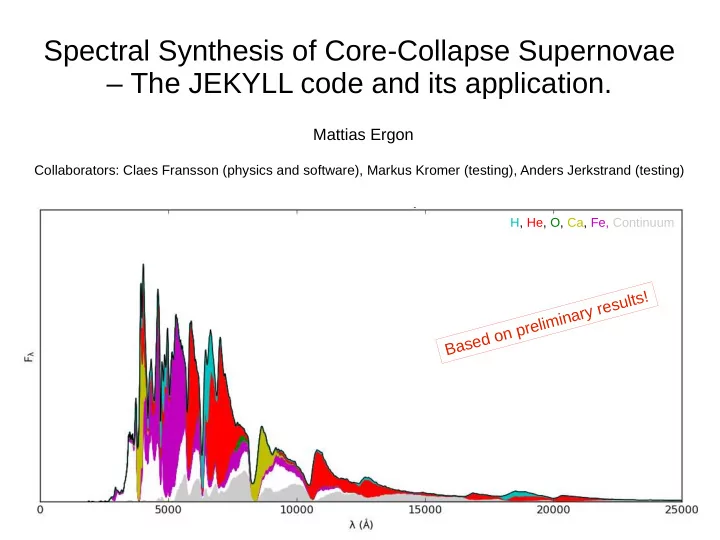

Spectral Synthesis of Core-Collapse Supernovae – The JEKYLL code and its application. Mattias Ergon Collaborators: Claes Fransson (physics and software), Markus Kromer (testing), Anders Jerkstrand (testing) H, He, O, Ca, Fe, Continuum Based on preliminary results!
The JEKYLL code What: Realistic* simulations of the spectral evolution, and the broad-band and bolometric lightcurves for SNe, in the photospheric and nebular phase. How: Full NLTE-solution for the matter and the radiation field, following (and extending) the method outlined by Leon Lucy (2002, 2003, 2005). * Restrictions: Homologues expansion. Spherical symmetry. Steady-state for the matter.
Method outline Matter Electron temperature Thermal equilibrium Ion level populations Statistical equilibrium Lambda iteration Non-thermal electrons Spencer-Fano equation Timebin iteration Radiation field (MC) Radiative transfer Radioactive decays energy deposition
NLTE NLTE: Non-LTE LTE: Local Thermodynamic Equilibrium In LTE all processes are in (near) equilibrium, and the state specified by a single parameter, the temperature. Optically thick Optically thin Collisional processes dominate Matter: LTE LTE Yes Radiation: NLTE NLTE NLTE No
NLTE NLTE: Non-LTE LTE: Local Thermodynamic Equilibrium In LTE all processes are in (near) equilibrium, and the state specified by a single parameter, the temperature. Optically thick Optically thin Saha ionization and Boltzman excitation equation Collisional processes dominate R Matter: LTE Diffusion approximation a LTE Yes d i Radiation: NLTE a t i v e t r a n s f e r e NLTE NLTE q No u a t i o n NLTE rate equations
NLTE NLTE: Non-LTE LTE: Local Thermodynamic Equilibrium In LTE all processes are in (near) equilibrium, and the state specified by a single parameter, the temperature. Optically thick Optically thin Saha ionization and Boltzman excitation equation Collisional processes dominate R Matter: LTE Diffusion approximation a LTE Yes d i Radiation: NLTE a t i v e t r a n s f e r e NLTE NLTE q No u a t i o n NLTE rate equations In the outer parts and at late times, SNe ejecta are neither optically thick, nor collisionally dominated, so a full NLTE solution is required.
Non-thermal electrons γ Compton scattering γ Radioactive decays e Non-thermal electrons Thermalization cascade Ionization Excitation Heating e
Non-thermal electrons γ Compton scattering γ Radioactive decays e Non-thermal electrons Thermalization cascade Ionization Excitation Spencer-Fano (Boltzman) equation Heating Non-thermal electron distribution e Problem solved by Kozma & Fransson (1998), and their original FORTRAN routine has been integrated into JEKYLL.
Other similar codes SEDONA (Kasen et al. 2006) SUMO (Jerkstrand et al. 2011) Geometry: 3-D Geometry: 1-D NLTE: No NLTE: Full Non-thermal ionization/excitation: No Non-thermal ionization/excitation: Yes Time-dependence: No Time-dependence: Radiation field Macroscopic mixing: Yes Macroscopic mixing: No Phase: Nebular Phase : Photospheric JEKYLL (Ergon et al. In prep) Geometry: 1-D NLTE: Full Non-thermal ionization/excitation: Yes Time-dependence: Radiation field Macroscopic mixing: Yes Phase: All ARTIS (Kromer et al. 2009) CMFGEN (Hillier 1998) Geometry: 3-D Geometry: 1-D NLTE: Ionization NLTE: Full Non-thermal ionization/excitation: No Non-thermal ionization/excitation: Yes Time-dependence: Radiation field Time-dependence: Full Macroscopic mixing: Yes Macroscopic mixing: No Phase : Photospheric Phase: All
Comparisons SUMO ARTIS Model 13G at 200 days In progress. CMFGEN Model 13G at 400 days T.B.D.
Type IIb models: Background Constructed and evolved through the nebular phase with SUMO in Jerkstrand et al. (2015). Evolved through the photospheric phase with JEKYLL in Ergon et al. (in prep). In the following I show some results for model 12C, which showed a reasonable agreement with SN 2011dh in the nebular phase. 56Ni He C/O H
Type IIb models: Spectral evolution Model 12C - Photospheric phase Model 12C - Nebular phase H, He, O, Ca, Fe, Continuum
Type IIb models: Broad-band lightcurves SN 2011dh: 3-150 days Model 12C: 3-150 days
Type IIb models: UV-MIR pseudo-bolometric lightcurve Model 12C: 3-100 days SN 2011dh: 3-100 days
Effect of NLTE: Bolometric lightcurve Model 12C : 3-100 days Model 12C: 3-100 days
Effect of NLTE: Bolometric lightcurve Model 12C : 3-100 days Model 12C: 3-100 days Non-thermal ionization/excitation - Off
Effect of NLTE: Bolometric lightcurve Model 12C : 3-100 days Model 12C: 3-100 days Non-thermal ionization/excitation - Off NLTE excitation - Off
Effect of NLTE: Ionization Electron fraction at 24.1 days Non-thermal ionization/excitation - Off NLTE excitation - Off
Effect of NLTE: Spectral evolution Non-thermal ionization/excitation - Off
Effect of NLTE: Bolometric lightcurve Model 12C : 3-100 days Model 12C: 3-100 days LTE + Opacity floor (HYDE)
Effect of NLTE: Bolometric lightcurve Model 12C : 3-100 days Model 12C: 3-100 days LTE + Opacity floor (HYDE) Arnett (1982) + Popov (1991)
Effect of NLTE: Bolometric lightcurve Model 12C : 3-100 days Model 12C : 3-100 days Model 12C: 3-100 days HYDE opacity floor : 0.024, 0.05, 0.1, 0.15, 0.2 cm^2 gram^-1
Mixing Macroscopic Microscopic Hydrodynamical instabilities → Macroscopic mixing of the nuclear burning zones. Macroscopic vs Microscopic mixing Different composition and (possibly) density Different temperature, degree of ionizaton etc. To simulate macroscopic mixing, JEKYLL supports virtual cells (Jerkstrand et al. 2011). Virtual cells represents clumps of macroscopically mixed material, and are randomly selected while the photons traverse the otherwise spherically symmetric ejecta.
Effect of mixing: Spectral evolution Macroscopic mixing Microscopic mixing H, He, O, Ca, Fe, Continuum
Effect of mixing: Bolometric lightcurve Microscopic Mixing Macroscopic Mixing
More to come ... ? Type Ic SNe Type IIL SNe ? Superluminous SNe ?
Recommend
More recommend